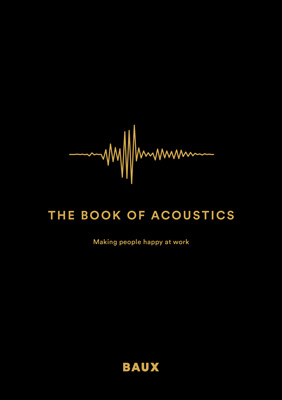The Book of Acoustics
Chapter 1.2 The fundamentals of sound control
Common sound wave behaviour in indoor spaces
Controlling sound in an indoor space isn’t just about addressing the source. After all, sometimes a sound is inevitable or necessary—such as a conversation in a workplace or an espresso machine in a cafe. Controlling sound is also about manipulating the way it behaves once it has been set into motion. Outdoors, a sound wave travels freely in a straight line. In an enclosed space, however, a sound wave behaves and reacts differently based on the kinds of obstacles it encounters, such as walls, furniture and people. A sound wave can bounce off an obstacle, move around it or change directions as it passes from one to the next.
Here are some of the most common types of sound wave behaviours in indoor spaces. A sound wave will typically exhibit a combination of these behaviours over the course of its lifetime.
ABSORPTION
Absorption occurs when a sound wave is absorbed by the object or material it encounters. A sound wave that is absorbed transforms into heat energy inside the object or material absorbing it. How much energy gets absorbed or continues to travel onward depends on the thickness and nature of the material. Too little absorption causes sound to reflect.
DIFFRACTION
Diffraction is when a sound wave either bends around the edge of the object it encounters, or passes through a narrow opening, such as a doorway, and then spreads out. Diffraction can lead to privacy issues and disruptions, especially in shared, mixed use spaces. It’s the reason why someone speaking in a room with an open door can be heard by the people sitting outside.
DIFFUSION
Diffusion typically occurs when the texture and hardness of the object or material is similar to the sound’s wavelength. Exactly how the sound diffuses depends on the nature of the surface texture. Too much diffusion can make it difficult to localise where a sound is coming from. Diffusion occurs when a sound wave diffuses or scatters in different directions upon encountering an object or material.
REFLECTION
Reflection happens when a sound wave hits an object or surface, such as a wall, and reflects or bounces back. Reflection is most pronounced in rooms with smooth and hard materials like marble or glass. Reflection can result in sound amplification, echos or reverberation. Too much reflection can make a room feel loud and irritating.
REFRACTION
Refraction occurs when a sound wave bends as it travels from one object or material to another. Both the direction of the sound wave and the speed at which it travels changes depending on the properties of the object or material as well as temperature. Refraction can result in so-called ‘shadow zones,’ where sound cannot be heard even when the source is within the listener’s view.
TRANSMISSION
Transmission takes place when a sound wave transfers from one material or medium to another, and then continues to travel out through the other side. How much transmission occurs depends on how well the acoustical impedances of the two materials match. Transmission becomes problematic when a sound originating from one room travels through the wall to be heard by the people next door.

